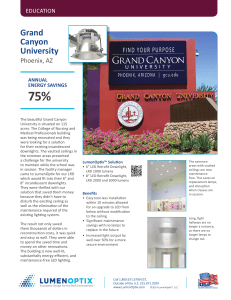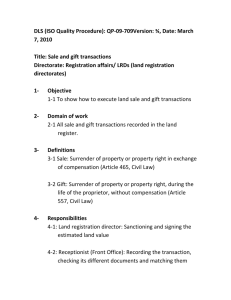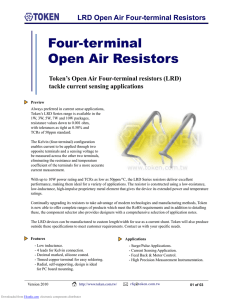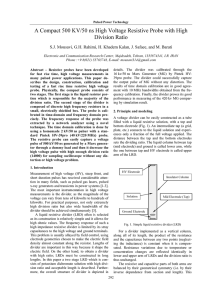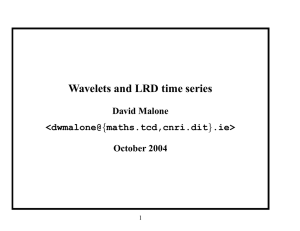data sheet lr-d overload relays
advertisement
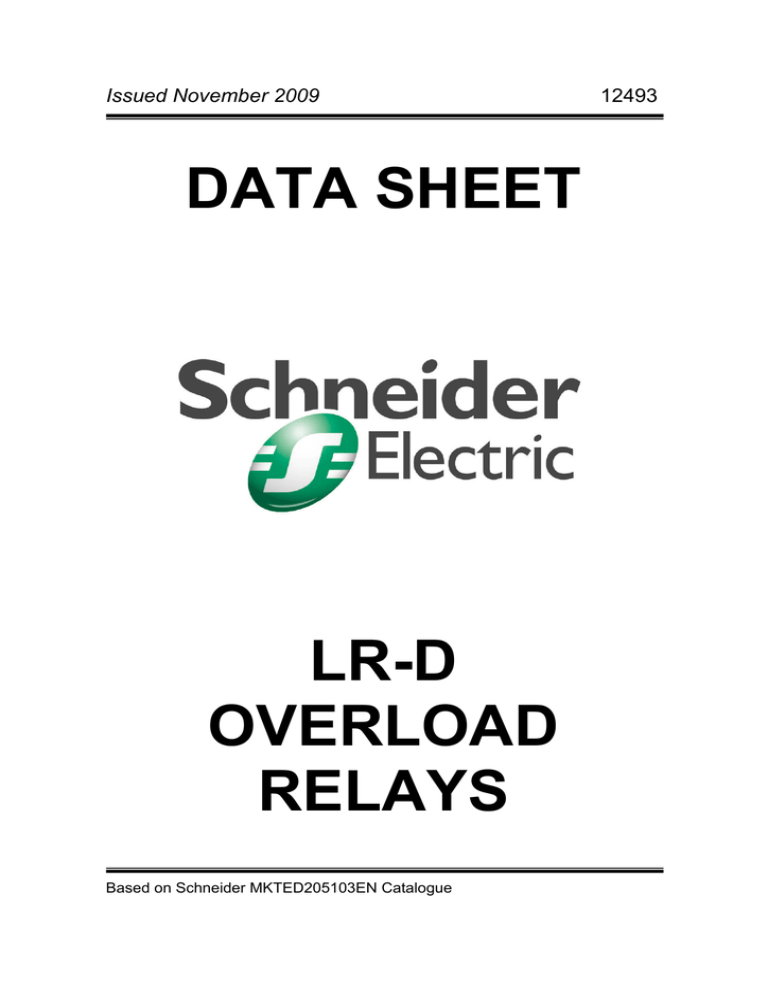
Issued November 2009 DATA SHEET LR-D OVERLOAD RELAYS Based on Schneider MKTED205103EN Catalogue 12493 General 6 12493 Protection components 6 Motor protection Operating conditions There are many possible causes of electric motor failure. One of the most common, and which is often accidental, is the utilisation of motors beyond the operating limits defined by the manufacturer or in abnormal ambient conditions. A statistical survey carried out in Britain, covering 9000 incidents of motor failure, gave the following results: Overloads 30 % Pollution (example: corrosive atmosphere) 19 % Phase failure 14 % Bearing failure 13 % Ageing (example: ambient temperature too high) 10 % Rotor faults 5% Miscellaneous 9% These faults are related to motors with a power rating of 37 kW or more. An examination of the above results shows that, in more than 50 % of cases, the fault is due to the effects of heating. Leaving aside the replacement of wearing parts, such as bearings, slip rings, brushes, etc., the life of a rotating machine is linked to that of its insulation. Provided that the temperature rise limit is not exceeded, the life expectancy of insulating materials is extremely long. It is decreased by approximately one half for an excess temperature rise of 10 °C. The operating temperature limit TL of an insulating material depends on the type of material and is the sum of the ambient air temperature AT (cooling air), the temperature rise limit TRL and an additional temperature rise value ATR considered necessary because the measurement of winding resistance variation does not determine the temperature of the hottest part of the motor winding, but only gives an average value for temperature rise. The diagram below defines the standardised limits for different classes of insulation. In all cases, the normal ambient cooling air temperature is fixed at 40 °C. ATR 180 165 155 TRL 140 130 125 120 115 TL 100 80 60 40 AT 20 0 E Based on Schneider MKTED205103EN Catalogue B F H Insulation classes Page 1 of 16 General (continued) 6 12493 Protection components 6 Motor protection The rated power of a motor corresponds to its temperature rise limit for an ambient temperature of 40 °C. The standard temperature rise limits for the different parts of a machine are given in the following table, which is an extract from publication IEC 60034-1. Temperature rise limit in °C Insulation class B F 80 100 H 125 Insulated winding (measurement by resistance) Commutators and slip-rings 80 90 (1) 100 (1) Bearings 60 (2) 60 (2) 60 When a motor is used at an ambient air temperature other than the normal value, its temperature rise limit should be modified in order to maintain the same maximum temperature limit. The result is that the motor operational power is no longer the same as its rated power. Also, the altitude of the installation, if this is above 1000 m, affects the cooling and increases the temperature rise. The following table gives the ratio between operational power and rated power, according to the operating conditions, for a given ambient temperature. It corresponds to insulation class B. Operational power / Rated power in watts Altitude m 1000 Ambient temperature 30 °C 35 °C 40 °C 1.07 1.04 1.00 45 °C 0.96 50 °C 0.92 55 °C 0.87 60 °C 0.82 1500 1.04 1.01 0.97 0.93 0.89 0.84 0.79 2000 1.01 0.98 0.94 0.90 0.86 0.82 0.77 2500 0.97 0.95 0.91 0.87 0.84 0.79 0.75 3000 0.93 0.91 0.87 0.84 0.80 0.76 0.71 3500 0.89 0.86 0.83 0.80 0.76 0.72 0.68 4000 0.83 0.81 0.78 0.75 0.72 0.68 0.64 The values shown in the above table are for guidance only. In effect, the derating of a motor depends on its size, insulation class, method of construction (self-ventilated or forced ventilation, degree of protection IP 23, IP 44, etc.), and varies according to the manufacturer. Also, in addition to the normal ambient conditions, the rated power of a motor is defined by the manufacturer for continuous duty S1. This covers continuous operation of sufficient duration to enable the motor to reach a steady temperature. It is this value of rated power that is normally shown on the motor plate. There are other standardised types of duty, such as temporary duty S2, or intermittent periodic duty type S3, S4 and S5, for which the motor manufacturer defines an operational power appropriate to each and different from the rated power. (1) For temperature rise limits of 90 °C and 100 °C the brushes must be selected with the agreement of the motor manufacturer. (2) These limit values may be exceeded, depending on the quality of the grease used and the applied loads. Based on Schneider MKTED205103EN Catalogue Page 2 of 16 General 6 12493 Protection components 6 Motor protection Selection of thermal protection To optimise the life of a motor, it is important to select the appropriate thermal protection which will prevent operation under abnormal heating conditions, whilst ensuring maximum continuity in the operation of the driven machine or associated plant by avoiding unnecessary stoppages. It is essential to know the real operating conditions: b ambient temperature, b operating altitude, b type of standard duty, in order to determine the operational values for the motor (power, current) and to be able to select efficient thermal protection. These operational values are given by the motor manufacturer. Various types of thermal protection devices are available: b thermal overload relays or thermal-magnetic motor circuit-breakers, b thermistor protection relays, with PTC thermistor probes (1) b multifunction relays. Protection by thermal overload relay A conventional thermal overload relay protects the motor in the following two cases: b overload, by monitoring the current drawn by each phase, b phase imbalance or failure, by its differential mechanism. It therefore covers 44% of the cases of motor failure. This type of protection relay is widely used, is extremely reliable and is a relatively low cost device. It is particularly recommended if there is a risk of rotor locking. Nevertheless, it has the disadvantage of not taking into account, with sufficient accuracy, the thermal state of the motor. The operating principle of this type of device is, in fact, based on the bending of bimetal strips caused by the current drawn by the motor. As the thermal inertias of the overload relay and motor are different, in some cases it may be possible to restart the motor following an overload trip even though its temperature is still too high. Protection by instantaneous electronic over current relays LR97 D and LT47 electronic over current relays have been developed to satisfy machine protection requirements. By monitoring the current through the current transformers with which they are equipped, they provide protection against: b overtorque or mechanical shock, b locked rotor (mechanical locking under steady state conditions), b phase failure. These relays are particularly recommended for providing mechanical protection on machines with: b high resistive torque, b high inertia, b and with strong probability of locking under steady state conditions. They do not incorporate a thermal overload memory and can therefore be used to provide motor protection in severe duty applications, such as: b long starting times, b frequent starting. These relays have definite time characteristics: current threshold and time based function Because of their two separate time settings "D-Time" (starting time) and "O-Time" (trip time during steady state), these over current relays can be combined with the motor-starter function. (1) PTC: Positive Temperature Coefficient Based on Schneider MKTED205103EN Catalogue Page 3 of 16 General (continued) 6 12493 Protection components 6 Resistance (Ω) Motor protection Protection by PTC thermistor relay 4000 Better monitoring of the internal motor temperature can be provided by PTC thermistor probes, embedded in the motor windings during manufacture, associated with a thermistor protection relay (type LT3 S). 1330 PTC probes are resistors with a positive temperature coefficient. Their resistance value increases very rapidly when their temperature reaches the Nominal Operating Temperature threshold, indicated by NOT on the curve opposite. 550 250 Their small size means that they have a low thermal inertia and can rapidly follow the temperature variations of their surroundings. 100 NOT +15 0 NOT -5 NOT NOT +5 -20 NOT -20 50 This is the only solution for motor protection in applications involving severe starting/ stopping (duties S3, S4, S5) and, likewise, for applications where the motor could be inadvertently overcooled. Temperature (°C) Markings complied with by universal probes “Mark A” (standard EC 60034-11-1A) Problems other than those due to thermal effect can also arise: earth fault, abnormal overheating of bearings, etc. More comprehensive protection can be obtained: b either by associating several types of protection device (example: thermal overload relay + thermistor protection relay + earth fault relay), b or by using a multifunction protection relay type LT6. Protection relays Relay type Thermal Over overload (1) current LR2 K, LRD, LR97D LR9 F Over current LT47 For use with PTC probes LT3 Multifunction LT6 Causes of overheating Slight overload Locked rotor Underload Supply phase failure Ventilation fault With PTC probes Abnormal rise in ambient temperature Shaft bearing seizure With PTC probes With PTC probes Insulation fault Protracted starting time Severe duty With PTC probes Ideally suited Possible solution Not suitable (no protection) (1) Or motor circuit-breaker type GV2 ME, for example. Based on Schneider MKTED205103EN Catalogue Page 4 of 16 TeSys protection components Description, characteristics 6 12493 6 3-pole thermal overload relays, model d Description 1 6 2, 5 4 RESET 3 0 1 3,5 5 3 STOP 4 7 LRD 01…35 1 37 46 50 41 A R A E S E T M TEST 5 3 Model d 3-pole thermal overload relays are designed to protect a.c. circuits and motors against overloads, phase failure, long starting times and prolonged stalling of the motor. 1 Adjustment dial Ir. 2 Test button. Operation of the Test button allows: - checking of control circuit wiring, - simulation of relay tripping (actuates both the N/O and N/C contacts). 3 Stop button. Actuates the N/C contact; does not affect the N/O contact. 4 Reset button. 5 Trip indicator. 6 Setting locked by sealing the cover. 7 Selector for manual or automatic reset. Relays LRD 01 to 35 are supplied with the selector in the manual position, protected by a cover. Deliberate action is required to move it to the automatic position. 4 2 6 NO 98 NC 97 95 96 LRD 3322…4369, LR2 D Environment Conforming to standards Product certifications Degree of protection Protective treatment Ambient air temperature around the device Operating positions without derating Shock resistance Vibration resistance Dielectric strength at 50 Hz Surge withstand Conforming to VDE 0106 Conforming to IEC 60068 Storage Normal operation, without derating (IEC 60947-4-1) Minimum and maximum operating temperatures (with derating) In relation to normal vertical mounting plane Permissible acceleration conforming to IEC 60068-2-7 Permissible acceleration conforming to IEC 60068-2-6 Conforming to IEC 60255-5 Conforming to IEC 60801-5 °C °C IEC 60947-1, IEC 60947-4-1, NF C 63-650 VDE 0660, BS 4941 CSA, UL, Sichere Trennung, PTB except LAD 4: UL, CSA. Protection against direct finger contact IP 2X “TH” - 60…+ 70 - 20…+ 60 °C - 40…+ 70 Any position 15 gn - 11 ms 6 gn kV kV 6 6 A V VA V W 5 24 100 24 100 A 5 mm2 1/2.5 mm2 1/2.5 mm2 1/2.5 N.m 1.7 mm2 1/2.5 mm2 1/2.5 Auxiliary contact characteristics Conventional thermal current Maximum sealed current a.c. supply consumption of the operating coils of controlled contactors d.c. supply (Occasional operating cycles of contact 95-96) Short-circuit protection By gG, BS fuses. Maximum rating or by GB2 circuit-breaker Connection to screw clamp terminals (Min/max c.s.a.) Flexible cable 1 or 2 conductors without cable end Flexible cable 1 or 2 conductors with cable end Solid cable 1 or 2 conductors without cable end Tightening torque Connection to spring terminals (Min/max c.s.a.) Flexible cable 1 or 2 conductors without cable end Flexible cable 1 or 2 conductors with cable end Based on Schneider MKTED205103EN Catalogue 48 200 48 100 110 400 110 50 220 600 220 45 380 600 440 25 600 600 – – Page 5 of 16 Characteristics 6 12493 TeSys protection components 6 3-pole thermal overload relays, model d Relay type LRD 01 …16, LR3 D01 …D16 LR D15pp LRD 21 …35, LR3 D21 …D35 LRD 3322 …33696 LR3 D3322 …D33696 LR2 D35pp LRD 4365 …4369 10 A 20 10 A 10 A 20 10 A Electrical characteristics of power circuit Tripping class Rated insulation voltage (Ui) Conforming to UL 508, IEC 60947-4-1 Conforming to IEC 60947-4-1 Conforming to UL, CSA Rated impulse withstand voltage (Uimp) Frequency limits Of the operating current Setting range Depending on model Connection to screw clamp terminals (Min/max c.s.a.) Flexible cable 1 conductor without cable end Flexible cable 1 conductor with cable end Solid cable without cable end 1 conductor Tightening torque Connection to spring terminals (Min/max c.s.a.) Flexible cable 1 conductor without cable end Solid cable 1 conductor without cable end V V 690 600 690 600 1000 600 kV 6 6 6 1000 600 except LRD 4369 6 Hz A 0…400 0.1…13 0…400 12…38 0…400 17…104 0…400 80…140 mm 2 1.5/10 1.5/10 4/35 4/50 mm 2 1/4 4/35 4/35 mm 2 1/6 4/35 4/50 N.m 1.7 1.85 1/6 except LRD 21: 1/4 1.5/10 except LRD 21: 1/6 2.5 9 9 mm 2 1.5/4 – 1.5/4 – – – mm 2 1.5/4 – 1.5/4 – – – °C A - 20…+ 60 - 30…+ 60 - 30…+ 60 1.14 ± 0.06 In Tripping current 30 % of In on one phase, the others at In Operating characteristics Temperature compensation Tripping threshold Sensitivity to phase failure Conforming to IEC 60947-4-1 Conforming to IEC 60947-4-1 - 20…+ 60 Tripping curves Average operating times related to multiples of the setting current Class 10 A Hours Time 2 20 20 Minutes 1 40 10 4 10 4 2 2 1 40 1 40 20 20 10 4 1 2 3 2 1 0,8 0,8 1 2 4 6 10 17 20 x the setting current (Ir) Class 20 A 2 1 40 Seconds Seconds Minutes Hours Time 10 1 2 3 4 2 1 0,8 0,8 1 2 4 6 10 17 20 x the setting current (Ir) 1 Balanced operation, 3-phase, from cold state. 2 2-phase operation, from cold state. 3 Balanced operation, 3-phase, after a long period at the set current (hot state). Based on Schneider MKTED205103EN Catalogue Page 6 of 16 12493 TeSys protection components Description, characteristics 6 6 3-pole electronic thermal overload relays, model LR9 D Description 1 2 5 4 3 Ir(A) 127 107 90 150 98 NO 97 95 NC 96 6 LR9 D electronic thermal overload relays are designed for use with contactors LC1 D115 and D150. In addition to the protection provided by model d thermal overload relays (see page 6/12) they offer the following special features: b protection against phase imbalance, b choice of starting class, b protection of unbalanced circuits, b protection of single-phase circuits, b alarm function to avoid tripping by load shedding. LR9 D5367…D5569 7 8 2 Class 5 4 3 Load Ir(A) 20 107 127 10 + 90 24 V - / 103 104 150 Alarm 98 NO 97 95 NC 1 2 3 4 5 6 7 8 96 1 Adjustment dial Ir Test button Stop button Reset button Trip indicator Setting locked by sealing the cover Class 10/Class 20 selector switch Selector for balanced load /unbalanced load 6 LR9 D67 and D69 Environment Conforming to standards Product certifications Degree of protection Protective treatment Ambient air temperature around the device (conforming to IEC 60255-8) Maximum operating altitude Operating positions without derating Shock resistance Vibration resistance Conforming to IEC 60529 and VDE 0106 Standard version Storage Normal operation Without derating In relation to normal vertical mounting plane Permissible acceleration conforming to IEC 60068-2-27 Permissible acceleration conforming to IEC 60068-2-6 Conforming to IEC 60255-5 Conforming to IEC 61000-4-5 Conforming to IEC 61000-4-2 IEC 60947-4-1, 255-8, 255-17, VDE 0660 and EN 60947-4-1 UL 508 , CSA 22-2 IP 20 on front panel with protective covers LA9 D11570p or D11560p °C °C m "TH” - 40…+ 85 - 20…+ 55 (1) 2000 Any position 13 gn - 11 ms 2 gn - 5 to 300 Hz Dielectric strength at 50 Hz Surge withstand Resistance to electrostatic discharge Resistance to radio-frequency Conforming to IEC 61000-4-3 conducted disturbance and NF C 46-022 kV kV kV 6 6 8 V/m 10 Resistance to fast transient currents Electromagnetic compatibility kV 2 Conforming to IEC 61000-4-4 Meet requirements Draft EN 50081-1 and 2, EN 50082-2 Electrical characteristics of auxiliary contacts Conventional thermal current Maximum sealed current a.c. supply consumption of the operating coils of controlled contactors d.c. supply (Occasional operating cycles of contact 95-96) Short-circuit protection By gG or BS fuses or by circuit-breaker GB2 Connection 1 or 2 conductors Flexible cable without cable end Tightening torque A V VA V W 5 24 100 24 100 A 5 mm2 Minimum c.s.a.: 1 Maximum c.s.a.: 2.5 1.2 N.m 48 200 48 100 110 400 110 50 220 600 220 45 380 600 440 25 600 600 – – (1) For operating temperatures up to 70 °C, please consult your Regional Sales Office. Based on Schneider MKTED205103EN Catalogue Page 7 of 16 Characteristics (continued) 6 TeSys protection components 12493 6 3-pole electronic thermal overload relays, model LR9 D Relay type LR9 D Electrical characteristics of power circuit Tripping class Conforming to UL 508, IEC 60947-4-1 Rated insulation voltage (Ui) Conforming to IEC 60947-4-1 Conforming to UL, CSA Rated impulse withstand voltage (Uimp) Frequency limits Of the operating current Setting range Depending on model Power circuit connections Width of terminal lug Clamping screw Tightening torque A 10 or 20 V V kV 1000 600 8 Hz A mm N.m 50…60. For other frequencies, please consult your Regional Sales Office (1) 60…150 20 M8 18 °C - 20…+ 70 A A 1.05 ± 0.06 In 1.12 ± 0.06 In Tripping in 4 s ± 20 % in the event of phase failure V V mA mA 24 17…32 y5 0…150 Self protected y 2.5 0.5…1.5 0.45 Operating characteristics Temperature compensation Tripping thresholds Conforming to IEC 60947-4-1 Alarm Tripping Conforming to IEC 60947-4-1 Sensitivity to phase failure Alarm circuit characteristics Rated supply voltage Supply voltage limits Current consumption Switching capacity Protection Voltage drop Cabling Tightening torque d.c. supply No-load Short-circuit and overload Closed state V Flexible cable without cable end mm 2 N.m (1) For applications involving the use of these overload relays with soft starters or variable speed drives, please consult your Regional Sales Office. LR9 D tripping curve Tripping time in seconds 1000 Average operating times related to multiples of the setting current. 100 1 2 10 1 0 1 1,12 2 3 4 5 6 7 8 9 10 11 12 x times the setting current (Ir) 1 Cold state curve 2 Hot state curve Based on Schneider MKTED205103EN Catalogue Page 8 of 16 References 6 12493 TeSys protection components 6 3-pole thermal overload relays, model d 810464 Differential thermal overload relays for use with fuses b Compensated relays with manual or automatic reset, b with relay trip indicator, b for a.c. or d.c. Relay setting range (A) Fuses to be used with selected relay aM (A) gG (A) BS88 (A) For use with contactor LC1 Reference Weight kg Class 10 A (1) with connection by screw clamp terminals or connectors 810465 LRD 08pp 810466 LRD 21pp 533573 LRD 33pp 0.10…0.16 0.16…0.25 0.25…0.40 0.40…0.63 0.63…1 1…1.6 1.6…2.5 2.5…4 4…6 5.5…8 7…10 9…13 12…18 16…24 23…32 30…38 17…25 23…32 30…40 37…50 48…65 55…70 63…80 80…104 80…104 95…120 110…140 80…104 95…120 110…140 0.25 0.5 1 1 2 2 4 6 8 12 12 16 20 25 40 40 25 40 40 63 63 80 80 100 125 125 160 100 125 160 2 2 2 2 4 4 6 10 16 20 20 25 35 50 63 80 50 63 100 100 100 125 125 160 200 200 250 160 200 250 – – – – – 6 10 16 16 20 20 25 32 50 63 80 50 63 80 100 100 125 125 160 160 200 200 160 200 200 D09…D38 D09…D38 D09…D38 D09…D38 D09…D38 D09…D38 D09…D38 D09…D38 D09…D38 D09…D38 D09…D38 D12…D38 D18…D38 D25…D38 D25…D38 D32 and D38 D40…D95 D40…D95 D40…D95 D40…D95 D50…D95 D50…D95 D65…D95 D80 and D95 D115 and D150 D115 and D150 D150 (2) (2) (2) LRD LRD LRD LRD LRD LRD LRD LRD LRD LRD LRD LRD LRD LRD LRD LRD LRD LRD LRD LRD LRD LRD LRD LRD LRD LRD LRD LRD LRD LRD 01 02 03 04 05 06 07 08 10 12 14 16 21 22 32 35 3322 3353 3355 3357 3359 3361 3363 3365 4365 4367 4369 33656 33676 33696 0.124 0.124 0.124 0.124 0.124 0.124 0.124 0.124 0.124 0.124 0.124 0.124 0.124 0.124 0.124 0.124 0.510 0.510 0.510 0.510 0.510 0.510 0.510 0.510 0.900 0.900 0.900 1.000 1.000 1.000 Class 10 A (1) with spring terminal connections (only for direct mounting on the contactor) LRD 083pp 0.10…0.16 0.16…0.25 0.25…0.40 0.40…0.63 0.63…1 1…1.6 1.6…2.5 2.5…4 4…6 5.5…8 7…10 9…13 12…18 16…24 0.25 0.5 1 1 2 2 4 6 8 12 12 16 20 25 2 2 2 2 4 4 6 10 16 20 20 25 35 50 – – – – – 6 10 16 16 20 20 25 32 50 D09…D38 D09…D38 D09…D38 D09…D38 D09…D38 D09…D38 D09…D38 D09…D38 D09…D38 D09…D38 D09…D38 D12…D38 D18…D38 D25…D38 LRD LRD LRD LRD LRD LRD LRD LRD LRD LRD LRD LRD LRD LRD 013 023 033 043 053 063 073 083 103 123 143 163 213 223 0.140 0.140 0.140 0.140 0.140 0.140 0.140 0.140 0.140 0.140 0.140 0.140 0.140 0.140 Class 10 A (1) with connection by lug-clamps Select overload relay with screw clamp terminals or connectors from the table above and add one of the following suffixes: b figure 6 for relays LRD 01 to LRD 35, b A66 for relays LRD 3322 to LRD 3365. The remaining references are suitable, as standard, for use with lug-clamps. Thermal overload relays for use with unbalanced loads Class 10 A (1) with connection by screw clamp terminals In the references selected above, change LRD (except LRD 4ppp) to LR3 D. Example: LRD 01 becomes LR3 D01. Thermal overload relays for use on 1000 V supplies Class 10 A (1) with connection by screw clamp terminals For relays LRD 06 to LRD 35 only, for an operating voltage of 1000 V, and only for independent mounting, the reference becomes LRD 33ppA66. Example: LRD 12 becomes LRD 3312A66. Order an LA7 D3064 terminal block separately, see page 12. (1) Standard IEC 60947-4-1 specifies a tripping time for 7.2 times the setting current I R : class 10 A: between 2 and 10 seconds. (2) Independent mounting Based on Schneider MKTED205103EN Catalogue Page 9 of 16 References (continued) 6 TeSys protection components 12493 6 3-pole thermal overload relays, model d 810468 Differential thermal overload relays for use with fuses b Compensated relays with manual or automatic reset, b with relay trip indicator, b for a.c. or d.c. Relay setting range (A) 810470 LRD 15pp LR2 D35pp Fuses to be used with selected relay aM (A) gG (A) BS88 (A) For use with contactor LC1 Reference D09…D32 D09…D32 D09…D32 D09…D32 D12…D32 D18…D32 D25 and D32 D25 and D32 D25 and D32 D40…D95 D40…D95 D40…D95 D50…D95 D50…D95 D65…D95 D80 and D95 LRD 1508 LRD 1510 LRD 1512 LRD 1514 LRD 1516 LRD 1521 LRD 1522 LRD 1530 LRD 1532 LR2 D3522 LR2 D3553 LR2 D3555 LR2 D3557 LR2 D3559 LR2 D3561 LR2 D3563 Weight Class 20 (1) with connection by screw clamp terminals 2.5…4 4…6 5.5…8 7…10 9…13 12…18 17…25 23…28 25…32 17…25 23…32 30…40 37…50 48…65 55…70 63…80 6 8 12 16 16 25 32 40 40 32 40 50 63 80 100 100 10 16 20 20 25 35 50 63 63 50 63 100 100 125 125 160 16 16 20 25 25 40 50 63 63 50 63 80 100 100 125 125 0.190 0.190 0.190 0.190 0.190 0.190 0.190 0.190 0.190 0.535 0.535 0.535 0.535 0.535 0.535 0.535 Electronic differential thermal overload relays for use with fuses b Compensated relays, with relay trip indicator, b for a.c., b for direct mounting on contactor or independent mounting (2). Relay setting range (A) Fuses to be used with selected relay aM (A) gG (A) For direct mounting beneath contactor LC1 Reference Weight Class 10 or 10A (1) with connection using bars or connectors 60…100 90…150 100 160 160 250 D115 and D150 D115 and D150 LR9 D5367 LR9 D5369 0.885 0.885 D115 and D150 D115 and D150 LR9 D5567 LR9 D5569 0.885 0.885 Class 20 (3) with connection using bars or connectors 60…100 90…150 125 200 160 250 Electronic thermal overload relays for use with balanced or unbalanced loads b Compensated relays, b with separate outputs for alarm and tripping. Relay setting range (A) Fuses to be used with selected relay aM (A) gG (A) For direct mounting beneath contactor LC1 Reference Weight Class 10 or 20 (1) selectable with connection using bars or connectors 60…100 100 160 D115 and D150 LR9 D67 0.900 90…150 160 250 D115 and D150 LR9 D69 0.900 (1) Standard IEC 60947-4-1 specifies a tripping time for 7.2 times the setting current IR : class 10: between 4 and 10 seconds, class 10 A: between 2 and 10 seconds, class 20: between 6 and 20 seconds. (2) Power terminals can be protected against direct finger contact by the addition of shrouds and/or insulated terminal blocks, to be ordered separately. Other versions Thermal overload relays for resistive circuits in category AC-1. Please consult your Regional Sales Office. Based on Schneider MKTED205103EN Catalogue Page 10 of 16 References 6 TeSys protection components 12493 6 3-pole thermal overload relays, model d Based on Schneider MKTED205103EN Catalogue Page 11 of 16 References (continued) 6 TeSys protection components 12493 6 3-pole thermal overload relays, model d Accessories Accessories (to be ordered separately) 533574 Description Pre-wiring kit allowing direct connection of the N/C contact of relay LRD 01…35 or LR3 D01…D35 to the contactor Terminal block (2) for clip-on mounting on 35 mm rail (AM1 DP200) or screw fixing; for fixing centres, see pages 6/20 to 6/22 Terminal block adapter for mounting a relay beneath an LC1 D115 or D150 contactor Mounting plates (4) for screw fixing on 110 mm centres Marker holder snap-in Bag of 400 labels (blank, self-adhesive, 7 x 16 mm) Stop button locking device 533575 LAD 7Cp Remote stop or electrical reset device (6) Remote tripping or electrical reset device (6) Block of insulated terminals For use with LC1 D09…D18 Sold in lots of 10 Unit reference LAD 7C1 (1) Weight kg 0.002 LC1 D25…D38 LRD 01…35 and LR3 D01…D35 LRD 1508…32 LRD 3ppp, LR3 D3ppp, LR2 D35pp 10 1 1 1 LAD 7C2 (1) LAD 7B106 LAD 7B105 LA7 D3064 (3) 0.003 0.100 0.100 0.370 LRD 3ppp, LR3 D3ppp, LRD 35pp 1 LA7 D3058 (3) 0.080 LRD 01…35, LR3 D01…D35, LRD 1508…32 LRD 3ppp, LR3 D3ppp, LR2 D35pp 10 DX1 AP25 0.065 1 LA7 D902 0.130 All relays except LRD 01…35 and LR3 D01…D35 (5) – 100 LA7 D903 0.001 1 LA9 D91 0.001 All relays except LRD 01…35, LR3 D01…D35 and LR9 D LRD 01…35 and LR3 D01…D35 10 LA7 D901 0.005 1 LAD 703p (7) (8) 0.090 All relays except LRD 01…35 and LR3 D01…D35 LR9 D 1 LA7 D03p (7) 0.090 2 LA9 F103 0.560 For use with Sold in lots of 1 Unit reference LAD 7305 (8) 1 LA7 D305 Remote control “Reset” function Description By flexible cable (length = 0.5 m) LRD 01…35 and LR3 D01…D35 All relays except LRD 01…35 and LR3 D01…D35 Weight kg 0.075 0.075 "Stop" and/or "Reset" functions LAD 7B106 The terminal protection shroud must be removed and the following 3 products Adapter All relays except LRD 01…35 and for door mounting LR3 D01…D35 Operating heads Stop All relays for spring return pushbutton Reset All relays must be ordered separately: 1 LA7 D1020 0.005 1 XB5 AL84101 0.027 1 XB5 AA86102 0.027 (1) These pre-wiring kits cannot be used with reversing contactors. (2) Terminal blocks are supplied with terminals protected against direct finger contact and screws in the open, "ready-to-tighten" position. (3) To order a terminal block for connection by lugs, the reference becomes LA7 D30646. (4) Do not forget to order the terminal block corresponding to the type of relay. (5) For LRD 01…35. (6) The time for which the coil of remote tripping or electrical resetting device LA7 D03 or LAD 703 can remain energised depends on its rest time: 1 s pulse duration with 9 s rest time; 5 s pulse duration with 30 s rest time; 10 s pulse duration with 90 s rest time; maximum pulse duration 20 s with a rest time of 300 s. Minimum pulse time: 200 ms. (7) Reference to be completed by adding the code indicating control circuit voltage. Standard control circuit voltages (for other voltages, please consult your Regional Sales Office): Volts 12 24 48 96 110 220/230 380/400 415/440 50/60 Hz – B E – F M Q N Consumption, inrush and sealed: < 100 VA c J B E DD F M – – Consumption, inrush and sealed: < 100 W. (8) Not compatible with 3-pole relays fitted with spring terminals. Based on Schneider MKTED205103EN Catalogue Page 12 of 16 Dimensions 12493 TeSys protection components 6 6 Thermal overload relays, model d LRD 01…35 LRD 1508…32 LRD 013…353 Direct mounting beneath contactors with screw clamp connections Direct mounting beneath contactors with screw clamp connections Direct mounting beneath contactors with spring terminal connections c b b e b c 70 45 92 45 c 66 LC1 b c D09…D18 D25…D38 123 137 See pages 5/82 and 5/83 LC1 b c e a D09 18 90 97 53 a D25 38 97 96 60 c D09 18 90 107 53 c D25 38 97 106 60 LC1 b c 45 D03 D383 168 See pages 5/82 and 5/83 LRD 3ppp Direct mounting beneath contactors LC1 D40…D95 and LP1 D40…D80 54 b e AM1 d 109 4 21 c d 30 70 g DL201 7 Control circuit: a.c. LC1 D40 LC1 D50 LC1 D65 LC1 D80 LC1 D95 Control circuit: d.c. LC1 D40, LP1 D40 LC1 D50 LC1 D65, LP1 D65 LC1 D80, D95, LPA D80 DL200 17 b c e g g (3-pole) (4-pole) 111 111 111 115.5 115.5 119 119 119 124 124 72.4 72.4 72.4 76.9 76.9 4.5 4.5 4.5 9.5 9.5 13 – 13 22 – 111 111 111 115.5 119 176 176 179.4 72.4 72.4 72.4 76.9 4.5 4.5 4.5 9.5 13 – 13 22 Direct mounting beneath contactors LC1 D115 and D150 189 174 150 267 255 LR9 D Direct mounting beneath contactors LC1 D115 and D150 132 132 AM1 d d DL200 and DR200 2.5 136 LRD 4ppp d 120 120 DE200 and EDppp 10.5 Based on Schneider MKTED205103EN Catalogue AM1 d DP200 and DR200 2.5 DE200 and EDppp 10.5 Page 13 of 16 Mounting 6 TeSys protection components 12493 6 Thermal overload relays, model d LRD 01…35 LRD 01…35 Independent mounting on 50 mm centres or on rail AM1 DP200 or DE200 Independent mounting on 110 mm centres 46 = LAD 7B106 35 = 10 45 110 125 = 2 6 80 5 37,5 50 85 15 LAD 7B106 = 90 DX1 AP25 2xØ6,5 Remote tripping or electrical reset LAD 703 (1) 32 (1) Can only be mounted on RH side of relay LRD 01…35. LRD 15pp Independent mounting on 50 mm centres or on rail AM1 DP200 or DE200 Remote tripping or electrical reset 45 LAD 7B105 = 35 = 41 82 4 50/65 LA7 D03 (1) 100 d 2xØ4,5 8 96 34 17 AM1 d DP200 2 DE200 9.5 Based on Schneider MKTED205103EN Catalogue (1) Can be mounted on RH or LH side of relay LR2 D15. Page 14 of 16 Mounting (continued) 6 TeSys protection components 12493 6 Thermal overload relays, model d LRD 3ppp and LR2 D35pp LRD 3ppp, LR2 D35pp and LR9 D Independent mounting on 50 mm centres or on rail AM1 DP200 or DE200 Remote tripping or electrical reset 75 LA7 D3064 = 50 = 51,5 100 75/87 2 LA7 D03 (1) 121 d 119 23,5 2xØ4,5 21 32 AM1 DP200 2 d AM1 DE200 9.5 (1) Can be mounted on RH or LH side of relay LRD 3ppp, LR2 D35pp or LR9 D. LRD 15 and LRD 3ppp Adapter for door mounted operator LA7 D1020 c Stop Reset 10 LA7 D1020 c : adjustable from 17 to 120 mm LRD, LRD 15 and LR9 D “Reset” by flexible cable LA7 D305 and LAD 7305 Mounting with cable straight e Mounting with cable bent c e c : up to 550 mm e : up to 20 mm Based on Schneider MKTED205103EN Catalogue M10x1 e : up to 20 mm Page 15 of 16 Schemes TeSys protection components 6 12493 6 Thermal overload relays, model d Pre-wiring kit LAD 7C1, LAD 7C2 A1 LRD, LR2 D and LR3 D _ KM A2 97 98 Test 95 Man. 96 5 Auto 6 3 4 2 1 Reset 95 96 _ LRD Stop L1 L2 L3 1 3 5 LR9 D5ppp 2 4 6 1/L1 3/L2 5/L3 _ KM1 (3) (4) (3) (2) Test Stop 95 97 98 96 6/T3 4/T2 2/T1 Man. reset 13 _A _ KM A1 _M 14 M 3 _ KM (1) Tripped. (2) Overload. (3) Setting current. (4) Specialised circuit. (1) A2 N L3 5 + L2 3 0V L1 1 LR9 D67 and LR9 D69 (5) 104 6 5/L3 + 4 3/L2 (3) 103 2 1/L1 _ KM1 (4) (3) (5) (2) Test Stop 95 97 A _ KM _ KM (1) A2 N 14 _M A1 M 3 13 _ 98 96 6/T3 4/T2 2/T1 Man. reset Based on Schneider MKTED205103EN Catalogue (1) Tripped. (2) Overload. (3) Setting current. (4) Specialised circuit. (5) Alarm. Page 16 of 16
